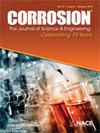Effect of Hydrogen on Creep Properties of SUS304 Austenitic Stainless Steel
IF 1.1
4区 材料科学
Q4 MATERIALS SCIENCE, MULTIDISCIPLINARY
引用次数: 4
Abstract
The objective of this study is to derive mechanistic insight into the degradation of metals in high-temperature hydrogen in order to enable the safety of evolving hydrogen technologies that operate at elevated temperature. Creep testing was performed in argon and hydrogen gases under absolute pressure of 0.12 MPa at 873 K. The material was JIS SUS304 austenitic stainless steel. Results revealed that the creep life (time to failure) and creep ductility (strain to failure) of the SUS304 in hydrogen gas and in argon displayed opposite trends. While the creep life (time to failure) of the SUS304 in hydrogen gas was significantly shorter than that in argon, creep ductility (strain to failure) was higher in hydrogen. Associated with the relatively higher creep ductility, evidence of transgranular microvoid coalescence was more prevalent on fracture surfaces produced in hydrogen compared to those produced in argon. In addition, analysis of the steady-state creep relationships in hydrogen and argon indicated that the same creep mechanism operated in the two environments, which was deduced as dislocation creep. Regarding the mechanisms governing reduced creep life in hydrogen, the effects of decarburization, carbide formation, and the hydrogen-enhanced localized plasticity mechanism were investigated. It was confirmed that these effects were not responsible for the reduced creep life in hydrogen, at least within the creep life range of this study. Alternately, the plausible role of hydrogen was to enhance the vacancy density, which led to magnified lattice diffusion (self-diffusion) and associated dislocation climb. As a consequence, hydrogen accelerated the creep strain rate and shortened the creep life.氢对SUS304奥氏体不锈钢蠕变性能的影响
本研究的目的是对高温氢中金属降解的机理进行深入研究,以确保在高温下运行的不断发展的氢技术的安全性。在氩气和氢气中进行蠕变试验,绝对压力为0.12 MPa,温度为873 K。材料为JIS SUS304奥氏体不锈钢。结果表明,SUS304在氢气和氩气中的蠕变寿命(失效时间)和蠕变延展性(失效应变)呈相反趋势。SUS304在氢气中的蠕变寿命(失效时间)明显短于氩气,但在氢气中的蠕变延展性(失效应变)更高。与相对较高的蠕变延展性有关,在氢气中产生的断口表面上穿晶微孔隙聚结的证据比在氩气中产生的断口更普遍。此外,对氢、氩两种环境下的稳态蠕变关系进行了分析,结果表明,两种环境下的蠕变机制是相同的,并推导为位错蠕变。研究了脱碳、碳化物形成和氢增强局部塑性的影响机理。结果表明,至少在本研究的蠕变寿命范围内,这些影响不是导致氢中蠕变寿命降低的原因。另外,氢的作用可能是增加空位密度,从而导致晶格扩散(自扩散)和相应的位错爬升。结果表明,氢加速了蠕变应变速率,缩短了蠕变寿命。
本文章由计算机程序翻译,如有差异,请以英文原文为准。
求助全文
约1分钟内获得全文
求助全文
来源期刊

Corrosion
MATERIALS SCIENCE, MULTIDISCIPLINARY-METALLURGY & METALLURGICAL ENGINEERING
CiteScore
2.80
自引率
12.50%
发文量
97
审稿时长
3 months
期刊介绍:
CORROSION is the premier research journal featuring peer-reviewed technical articles from the world’s top researchers and provides a permanent record of progress in the science and technology of corrosion prevention and control. The scope of the journal includes the latest developments in areas of corrosion metallurgy, mechanisms, predictors, cracking (sulfide stress, stress corrosion, hydrogen-induced), passivation, and CO2 corrosion.
70+ years and over 7,100 peer-reviewed articles with advances in corrosion science and engineering have been published in CORROSION. The journal publishes seven article types – original articles, invited critical reviews, technical notes, corrosion communications fast-tracked for rapid publication, special research topic issues, research letters of yearly annual conference student poster sessions, and scientific investigations of field corrosion processes. CORROSION, the Journal of Science and Engineering, serves as an important communication platform for academics, researchers, technical libraries, and universities.
Articles considered for CORROSION should have significant permanent value and should accomplish at least one of the following objectives:
• Contribute awareness of corrosion phenomena,
• Advance understanding of fundamental process, and/or
• Further the knowledge of techniques and practices used to reduce corrosion.
 求助内容:
求助内容: 应助结果提醒方式:
应助结果提醒方式:


